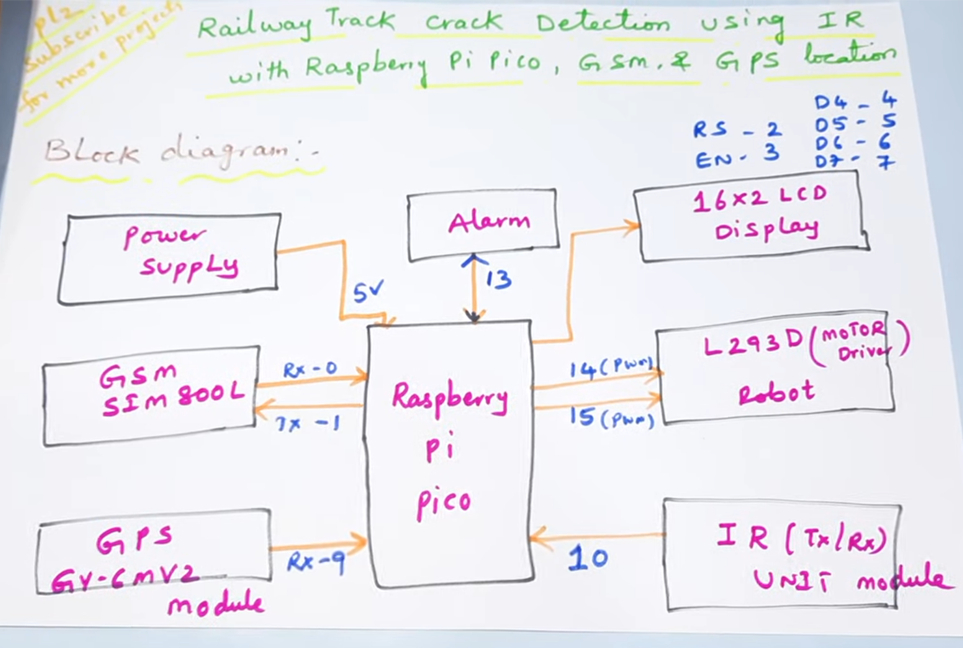Raspberry Pi Pico Robot Detects Cracks in Railway Tracks
SVSEmbedded’s latest Raspberry Pi project is a shining example of how a little ingenuity can help make the world around us a safer place. Using a Raspberry Pi Pico, they’ve created a custom robot that can ride along railway tracks looking for potential cracks and notifying users of the exact location in need of repairs.
The Pico works as the main driver and is in charge of locomoting the robot, detecting cracks, determining the location information and even notifying the users. We’ve seen similar projects in the past but this is the first time we’ve seen it done with a Pico. Compared to full-sized Pis, this is a lower-cost system that uses less power, making it a more optimal choice. Seeing as the Pico W was just released, we can’t help but appreciate the potential this project has for future developers looking to integrate the new board into their projects.

This project is one of many created by the team at SVSEmbedded who offers their work in the form of kits that students and teachers can use to help in their microelectronics journey. Previous examples of their work include this Pico-powered RFID-based attendance system and this crash detection robot which has a similar framework to this crack detection system.
To recreate this project, you’ll need a Raspberry Pi Pico, a power source, an alarm module, one LCD display (SVSEmbedded is using a 16 x 2 screen), a GPS module, one GSM module, a motor driver (in this case, an L293D driver board is used) along with an IR module. It would also be possible to substitute components, for example, the IR module could be replaced with an ultrasonic sensor.
The Pico powers a couple of motors to push the robot along the tracks. An IR sensor is pointed toward the tracks and if it detects a crack, the alarm sounds and the Pico triggers the GPS module to log the location. Once the data is collected, it’s then transmitted via an SMS message using the GSM module.
If you want to make this Raspberry Pi project at home, you can buy the components listed above and use the information shared as a guide or otherwise purchase everything you need together in one of their kits. Check out the official project page for more details and be sure to follow SVS Embedded for future developments and microelectronics kits.
Get Tom's Hardware's best news and in-depth reviews, straight to your inbox.

Ash Hill is a contributing writer for Tom's Hardware with a wealth of experience in the hobby electronics, 3D printing and PCs. She manages the Pi projects of the month and much of our daily Raspberry Pi reporting while also finding the best coupons and deals on all tech.
-
digitalgriffin Not a bad little robot and quite clever how it sends SMS GPS coordinates.Reply
However it has limitations using IR. Cracks are usually found using XRay scanners. We'll also have to see was it's resolution is over various types of track (ie: Rusty track) and gap sizes. At 88fps (60MPH) will it detect a depth change of 1"? (That's 1/88 of a second)
I think US FRA standards are < .25" gap. So that's a sampling rate > 352Hz. -
FunSurfer To the inventor:Reply
If your sensor can detect small cracks successfully you need to patent it quickly, lose the robot just install the sensor directly on the trains. Two sensors needed, one on each side of the train above the rail so trains can constantly monitor the railway, detect small cracks when they form and send their location. -
passivecool Reply
Amazing that the companies who spend billions every year maintaining railway tracks never figured out they could solve all their problems with a quaint school project robot. :rolleyes:FunSurfer said:you need to patent it quickly -
digitalgriffin ReplyFunSurfer said:To the inventor:
If your sensor can detect small cracks successfully you need to patent it quickly, lose the robot just install the sensor directly on the trains. Two sensors needed, one on each side of the train above the rail so trains can constantly monitor the railway, detect small cracks when they form and send their location.
The real problem here is resolution. This detects only a specific defect-gaps. While this is a more critical defect, cracked rail is almost as dangerous. It can break and separate quite easily. You need xrays for this. This is why they have sperry rail cars.
https://sova.si.edu/record/NMAH.AC.0497
Smithsonian link.
